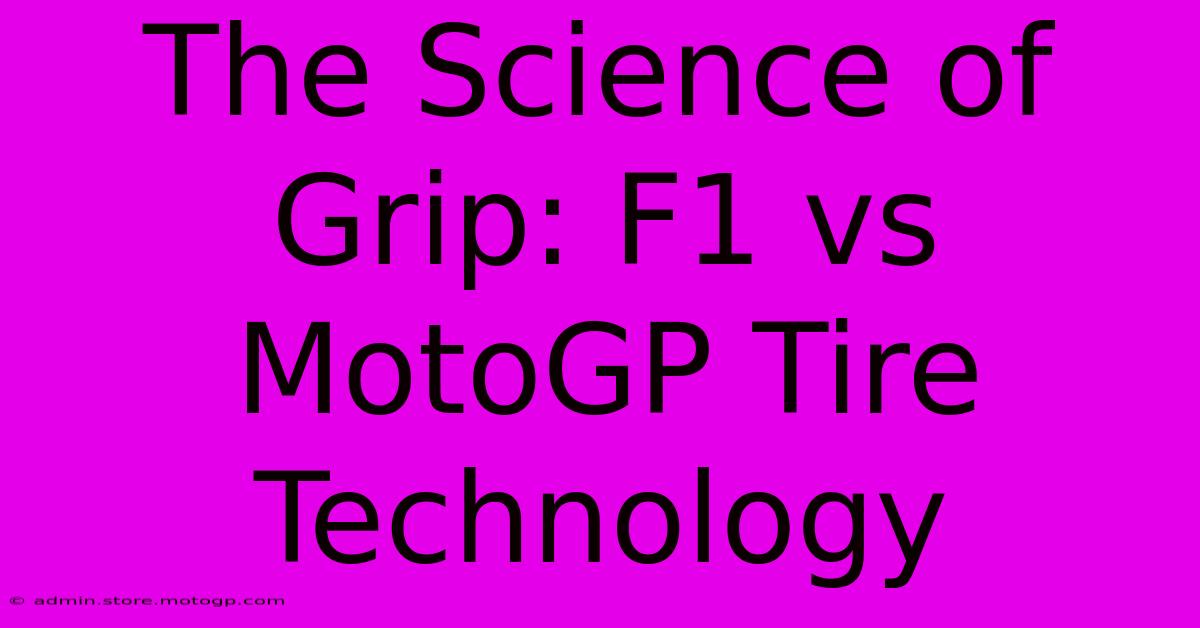The Science Of Grip: F1 Vs MotoGP Tire Technology

Table of Contents
The Science of Grip: F1 vs MotoGP Tire Technology
The roar of engines, the screech of tires, the breathtaking speeds – Formula 1 and MotoGP represent the pinnacle of motorsport. While both disciplines demand incredible levels of grip, the tire technology employed differs significantly due to the contrasting nature of the vehicles and racing surfaces. This article delves into the fascinating science behind the grip generated by F1 and MotoGP tires, exploring the key differences and similarities.
Understanding the Grip Equation
Before comparing F1 and MotoGP tires, it's crucial to understand the fundamental factors contributing to grip. These include:
- Tire Compound: The rubber compound's chemical makeup directly impacts its stiffness, heat generation, and ultimately, its grip level. Softer compounds generally offer higher grip but wear out faster.
- Tire Construction: The internal structure of the tire – including carcass, belts, and sidewalls – influences its ability to deform under load, maximizing contact patch and distributing forces effectively.
- Tire Pressure: Optimal tire pressure is crucial for maintaining the correct contact patch and distributing forces evenly. Incorrect pressure compromises grip and handling.
- Track Surface: The surface’s texture, temperature, and cleanliness significantly affect the tire's ability to adhere. A smooth, clean surface provides different grip characteristics compared to a rough, dirty one.
- Aerodynamics: While not directly related to the tire itself, aerodynamic downforce significantly increases the load on the tires, boosting grip. This is particularly crucial in F1.
- Temperature: Tire temperature is critical. Tires need to operate within a specific temperature window to achieve peak grip. Too cold, and grip is reduced; too hot, and the tire overheats and degrades.
F1 Tire Technology: The Downforce Advantage
Formula 1 cars are renowned for their immense aerodynamic downforce, generating significant grip through high vertical load. This allows for the use of comparatively harder tire compounds compared to MotoGP. F1 tires typically feature:
- Wider Contact Patch: F1 cars utilize significantly wider tires than MotoGP bikes to maximize contact area with the track surface, enhancing grip under high cornering speeds.
- Higher Stiffness: The high downforce means the tires can be designed with stiffer construction, offering better stability at high speeds.
- Slicks: F1 exclusively employs slick tires (without grooves), providing the maximum possible contact area for optimal grip in dry conditions.
- Compound Variations: Teams have access to a range of tire compounds offered by the sole supplier (Pirelli), allowing them to strategically select options based on track characteristics and race strategy.
The Challenges of F1 Tire Management:
Despite the high levels of grip available, F1 tire management remains crucial. The immense forces at play cause significant tire wear, and teams need to carefully manage tire temperature and degradation to maintain optimal performance throughout a race.
MotoGP Tire Technology: The Art of Lean Angle
MotoGP bikes rely less on aerodynamic downforce and more on the rider's skill in leaning into corners at incredibly steep angles. This necessitates a fundamentally different approach to tire design:
- Narrower Contact Patch: Compared to F1, MotoGP tires have a narrower contact patch, but they rely heavily on maximizing the available grip within that area.
- Softer Compounds: To maintain grip at high lean angles, MotoGP tires utilize softer rubber compounds. This results in higher grip but also faster wear.
- Grooved Tires: MotoGP bikes use grooved tires (with tread patterns) to enhance water drainage and grip in wet conditions. These grooves sacrifice some dry grip.
- Construction for Flexibility: The tire construction needs to accommodate significant sidewall flex as the bike leans into corners.
The Challenges of MotoGP Tire Management:
Tire management in MotoGP is extremely demanding. The combination of high lean angles, aggressive braking, and varied track surfaces causes rapid wear and temperature fluctuations. Riders must master the art of finding the optimal temperature window and adapting their riding style to manage tire wear.
Key Differences Summarized:
| Feature | F1 | MotoGP |
|---|---|---|
| Downforce | High | Low |
| Tire Width | Wider | Narrower |
| Tire Compound | Relatively Harder | Relatively Softer |
| Tire Type | Slicks | Grooved (Dry and Wet) |
| Contact Patch | Larger | Smaller, but highly utilized |
| Grip Source | Aerodynamic Downforce, Wide Contact | Lean Angle, Tire Compound, Rider Skill |
Conclusion: A Tale of Two Approaches
Both F1 and MotoGP showcase remarkable feats of tire technology, each tailored to the unique demands of their respective racing disciplines. While F1 relies on massive downforce and wide contact patches to generate grip, MotoGP relies on rider skill, tire compound, and precise tire management. The science behind achieving grip in these exhilarating sports constantly evolves, pushing the boundaries of material science and engineering. The constant pursuit of that perfect contact patch continues to drive innovation and breathtaking performance.

Thank you for visiting our website wich cover about The Science Of Grip: F1 Vs MotoGP Tire Technology. We hope the information provided has been useful to you. Feel free to contact us if you have any questions or need further assistance. See you next time and dont miss to bookmark.
Featured Posts
-
Top Speed Moto Gp Bike Witness The Power Of Innovation And Design
Feb 20, 2025
-
Moto Gp Watch Experience The Intensity Of The Rivalry
Feb 20, 2025
-
Moto 3 Motorcycle A Symphony Of Speed And Sound
Feb 20, 2025
-
Your Cota Survival Guide Formula 1 Austin Map
Feb 20, 2025
-
Unleash Your Inner Fan Cota Merchandise
Feb 20, 2025
